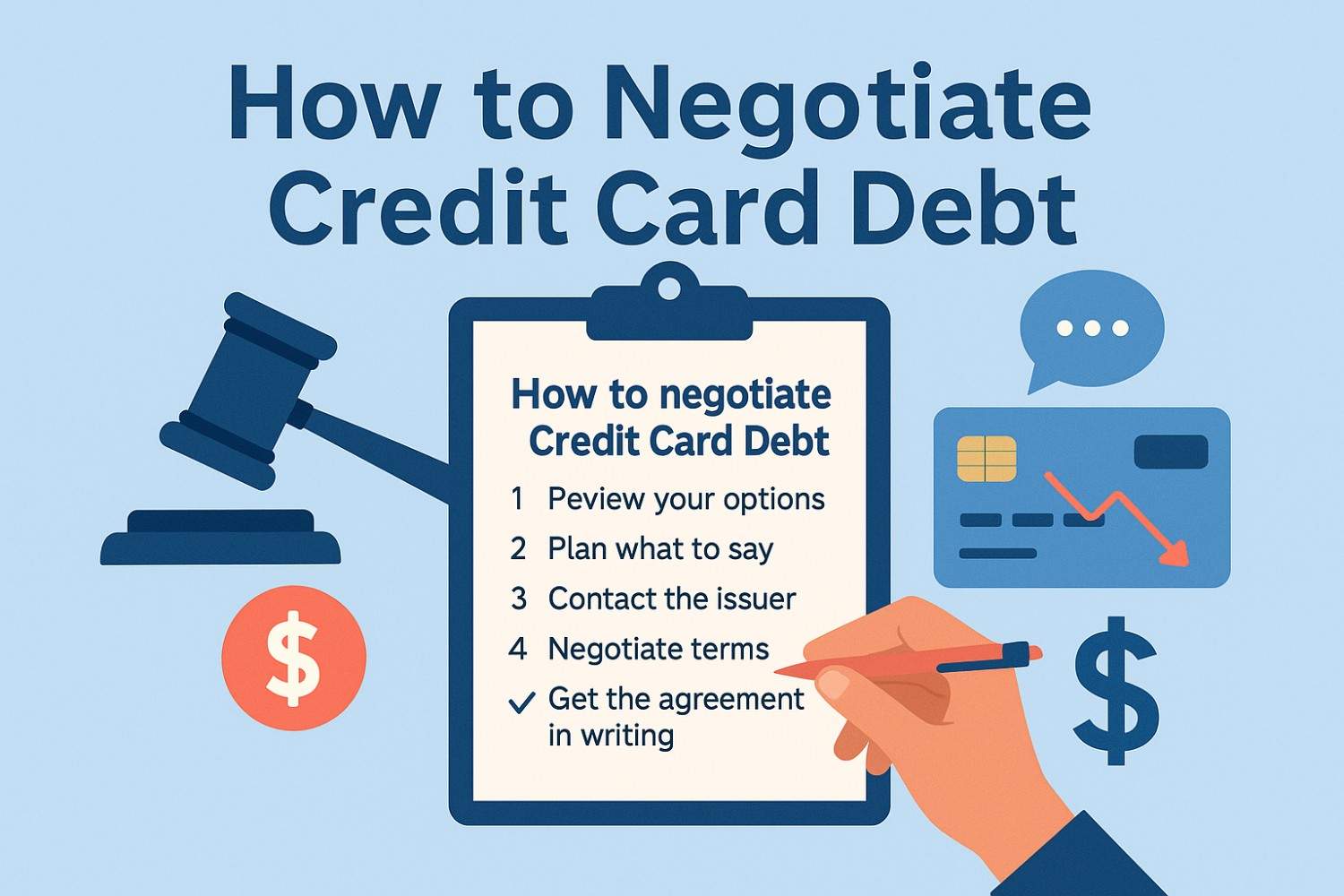If you’re wondering how to negotiate credit card debt, you’re not alone—and yes, you can do a lot yourself with a phone, a plan, and a few smart scripts. In this guide I’ll show you what to prepare, what to say, and how to lock the deal in writing—plus the trade-offs to watch.
What should you do first before you call your card issuer?
Start with a quick prep checklist. List each card, balance, APR, minimum payment, and delinquency status. Decide your primary goal: lower APR, fee reversal, hardship plan (temporary relief), or a lump-sum settlement if you’re behind and can’t catch up. Leading consumer sources outline this same sequence—prep, choose an option, then call—because it matches how issuers make decisions.
Next, verify any debt that’s already in collections. Under federal rules, collectors must send a validation notice and you generally have 30 days to dispute in writing—this protects you from paying an error and gives you leverage.
Finally, pick the best path for your situation:
- If you’re current but struggling: ask for a lower APR or fee waivers; some issuers also offer hardship programs with reduced rates or payments for a set period.
- If you’re seriously behind: explore a lump-sum settlement you can actually afford—then get the terms in writing.
Exactly what should you say to negotiate credit card debt?
Use a simple, respectful script and keep notes (date, name, outcome). Here’s a template you can adapt:
- Lower APR / Payment reduction (current account):
“I’ve been a customer for __ years. I’m experiencing a temporary hardship and need a lower APR or payment to stay current. Can you reduce my APR to __% for the next 6–12 months or place me in a hardship program?”
(Be ready to show why it helps you avoid delinquency and what payment you can sustain.)
- Fee reversal:
“I had a one-time lapse. I can pay __ today if you remove the late/over-limit fee so I can get back on track.” - Settlement (delinquent/collections):
“I can’t afford the full balance. Based on my budget, I can offer $__ as a lump-sum settlement. If we agree, will you confirm in writing that the account will be reported as ‘paid/settled’ and that I’ll owe no additional amount?”
(Government guidance stresses confirming the debt and getting agreements in writing.)
Pro tip: stay calm, repeat your request, and escalate politely to a supervisor when needed. If the answer is no today, call back; persistence often works. Even the FTC suggests you can—and should—do this yourself.
What are your options—and what are the trade-offs?
Lower APR / Hardship program
- Pros: Keeps the account open; reduces interest and payment stress.
- Cons: Terms are temporary; you may need to sign a program agreement and follow strict rules.
Lump-sum settlement
- Pros: Ends the balance quickly and may cost less than paying in full.
- Cons: Creditor may mark the account “settled,” which can hurt your credit; forgiven debt may be taxable; never pay a third-party settlement firm upfront.
Nonprofit credit counseling / DMP
- Pros: A counselor can help craft an affordable plan and sometimes secure fee/interest concessions.
- Cons: You must commit to a structured repayment plan; some cards may be closed. (Consider it when DIY calls stall.)
Context: Household debt is elevated in 2025, so you’re negotiating in a market where relief options are common—but documentation matters more than ever.
How do you lock in the deal and protect your credit?
- Get it in writing before you pay—letter or secure message stating the amount, due dates, interest/fee terms, and how the account will be reported. Agencies and banks alike emphasize this.
- Pay exactly as agreed (settlements often require cashier’s checks or a one-time deadline).
- Monitor your credit reports 30–60 days later and dispute inaccuracies if the reporting doesn’t match the agreement.
Frequently Asked Questions
1. Can I negotiate if my account is still current?
Yes. Ask for a rate reduction or a hardship plan to avoid falling behind. Issuers often have playbooks for temporary relief when you call with a clear budget and goal.
2. What percentage do creditors accept for a settlement?
It varies by issuer, balance, and delinquency. There’s no universal number, but settlements typically become realistic after serious delinquency. Focus on what you can pay in one or two installments and be ready to document hardship. Always confirm the debt and the final terms in writing.
3. Will the issuer close my card if I accept hardship help or settle?
It’s possible. Hardship plans can include account restrictions, and settlements on delinquent accounts usually mean the card gets closed and might be reported as “settled.” Understand the trade-offs before you accept.
4. Should I hire a debt settlement company?
Be cautious. Regulators warn about advance-fee settlement companies and over-promising results. If you need help, consider an accredited nonprofit credit counselor instead or negotiate directly with the creditor at no cost.
So…what’s the smartest way to approach how to negotiate credit card debt?
Lead with prevention: if you’re still current, ask for a lower APR or a hardship program to keep your account healthy. If you’re behind, propose a realistic settlement you can afford once—and insist on written confirmation before you pay. Keep meticulous notes, verify any collection debt, and don’t let anyone rush you into fees you don’t need.
And if things have already escalated to legal action, know that you can sometimes get a credit card lawsuit dismissed—especially if the creditor can’t prove ownership of the debt, validate the amount, or show the required documentation. Respond promptly to the summons, request verification in writing, and consider legal advice before agreeing to anything.
Do it step by step, in writing, and on your terms. You’ve got this.











